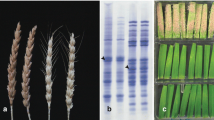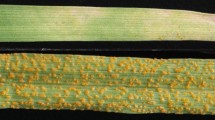Abstract
We have identified AFLP markers tightly linked to the locus conferring resistance to the leaf rust Melampsora larici-populina in Populus. The study was carried out using a hybrid progeny derived from an inter-specific, controlled cross between a resistant Populus deltoides female and a susceptible P. nigra male. The segregation ratio of resistant to susceptible plants suggested that a single, dominant locus defined this resistance. This locus, which we have designated Melampsora resistance (Mer), confers resistance against E1, E2, and E3, three different races of Melampsora larici-populina. In order to identify molecular markers linked to the Mer locus we decided to combine two different techniques: (1) the high-density marker technology, AFLP, which allows the analysis of thousands of markers in a relatively short time, and (2) the Bulked Segregant Analysis (BSA), a method which facilitates the identification of markers that are tightly linked to the locus of interest. We analyzed approximately 11,500 selectively amplified DNA fragments using 144 primer combinations and identified three markers tightly linked to the Mer locus. The markers can be useful in current breeding programs and are the basis for future cloning of the resistance gene.
Similar content being viewed by others
References
Bradshaw HD Jr, Stettier RF (1993) Molecular genetics of growth and development in Populus. I. Triploidy in hybrid poplars. Theor Appl Genet 86:301–307
Bradshaw HD Jr, Stettler RF (1995 a) Molecular genetics of growth and development in Populus. IV. Mapping QTLs with large effects on growth, and phenology traits in a forest tree. Genetics 139:963–973
Bradshaw HD Jr, Stettler RF (1995 b) Field trials to identify quantitative trait loci underlying growth, morphology, and stress response in Populus. In: Int Poplar Symp. University of Washington, Seattle, pp 106–109
Bradshaw HD Jr, Villar M, Watson BD, Otto KG, Stewart S, Stettler RF (1994) Molecular genetics of growth and development in Populus. III. A genetic linkage map of a hybrid poplar composed of RFLP, STS, and RAPD markers. Theor Appl Genet 89:167–178
Dellaporta SL, Wood J, Hicks JB (1983) A plant DNA minipreparation: Version II. Plant Mol Biol Rep 1:19–21
Food and Agriculture Organization (1980) Poplars and willows in wood production and land use (F.A.O. For Ser Vol. 10). F.A.O., Rome
Jouanin L, Brasileiro ACM, Leplé JC, Pilate G, Cornu D (1993) Genetic transformation: a short review of methods and their applications, results and perspectives for forest trees. Ann Sci For 50:325–336
Kosambi DD (1994) The estimation of map distances from recombination values. Ann Eugen 12:172–175
Leplé JC, Brasileiro ACM, Michel MF, Delmotte F, Jouanin L (1992) Transgenic poplars: expression of chimeric genes using four different constructs. Plant Cell Rep 11:137–141
Mather K (1938) The measurement of linkage in heredity (Methuen's monographs on biological subjects). Methuen, London
Michelmore RW, Paran I, Kesseli RV (1991) Identification of markers linked to disease-resistance genes by bulked segregant analysis:a rapid method to detect markers in specific genomic regions by using segregating populations. Proc Natl Acad Sci USA 88:9828–9832
Neale DB, Harry DE (1994) Genetic mapping in forest trees: RFLPs, RAPDs and beyond. AgBiotech News Inf 6:107N-114N
Ostry ME, Wilson LF, McNabb HS, Moore LM (1989) A guide to insect, disease, and animal pests of poplars. USDA For Serv Agric Handb 677:20–22
Paran I, Michelmore RW (1993) Development of reliable PCR-based markers linked to downy mildew resistance genes in lettuce. Theor Appl Genet 85:985–993
Pinon J (1973) Les rouilles du peuplier en France. Eur J For Pathol 3:221–228
Pinon J (1992) Variability in the genus Populus in sensibility to Melampsora rusts. Silvae Genet 41:25–33
Sax K (1923) The association of size differences with seed-coat pattern and pigmentation in Phaseolus vulgaris. Genetics 8:552–560.
Tanksley SD, Ganal MW, Martin GB (1995) Chromosome landing: a paradigm for map-based gene cloning in plants with large genomes. Trends Genet 11:63–68
Thomas CM, Vos P, Zabeau M, Jones DA, Norcott KA, Chadwick BP, Jones DJG (1995) Identification of amplified restriction fragment polymorphism (AFLP) marker tightly linked to the tomato Cf-9 gene for resistance to Cladosporium fulvum. Plant J 8:785–794
Vos P, Hogers R, Bleeker M, Reijans M, van de Lee T, Hornes M, Frijters A, Pot J, Peleman J, Kuiper M, Zabeau M (1995) AFLP: a new technique for DNA fingerprinting. Nucleic Acids Res 23:4407–4414
Wang J, Hall R (1995) Comparison of DNA content and chromosome numbers in species and clones of poplar. In: Int Poplar Symp. University of Washington, Seattle, pp 93 (Abstr).
Author information
Authors and Affiliations
Additional information
Communicated by P. M. A. Tigerstedt
Rights and permissions
About this article
Cite this article
Cervera, M.T., Gusmão, J., Steenackers, M. et al. Identification of AFLP molecular markers for resistance against Melampsora larici-populina in Populus . Theoret. Appl. Genetics 93, 733–737 (1996). https://doi.org/10.1007/BF00224069
Received:
Accepted:
Issue Date:
DOI: https://doi.org/10.1007/BF00224069




